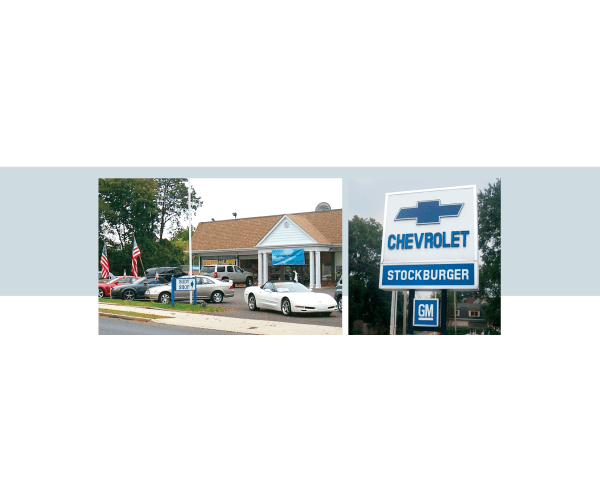
Stockburger Chevrolet/Chrysler: New Paging System
Stockburger Chevrolet/Chrysler: New Paging System

Challenge
We’ve all been startled by those annoying general pages – that high volume, distorted message that blasts from a big speaker somewhere when you least expect it. The often-garbled message is then repeated several times as the pager searches vainly for the pagee. The result for many businesses is annoyed customers, interrupted sales, and service delays as employees are tracked down by general paging and make their way to a location where they can respond.
Conventional multi-zone paging systems are sometimes the answer, but if a business needs to connect several buildings or tie in remote locations, a dedicated, hard-wired system can get expensive fast. For Stockburger Chevrolet/Chrysler of Newtown, Pennsylvania, this was the challenge they faced.
An active, two-location auto dealer, Stockburger’s business features a main downtown Newtown location including a Chevy dealership, body shop, and parts and service buildings, and a single-building Chrysler dealership two blocks away. “Previously we had separate phone systems with separate vendors for the two locations,” stated George Stockburger V, president of Stockburger Chevrolet/Chrysler. “To page between locations, you had to make a phone call, have someone at the other location page the person you wanted to reach, then they had to call you back. It was awkward and time-consuming, to say the least.”
- One multi-building location and one remote building requires easy, seamless, efficient paging system
- Wide range of paging requirements – from pinpoint interior paging to outdoor paging with minimal neighborhood disturbance
- Multi-zone paging needed to improve paging procedure efficiency and employee response time while reducing the overall number of pages
Fortunately, Stockburger Chevrolet/Chrysler hired information technology consultant and networks system installer Cratin Computing Company of Fort Washington, Pennsylvania, to install a new phone system in both locations, providing a number of enhanced, integrated products and services, including Voice over Internet Protocol (VoIP) communications. Cratin turned to Bogen Communications for a VoIP paging solution developed by Bogen and Multi-Tech Systems, enabling multi-zone paging to be piggy-backed over Stockburger’s data network. This innovative solution utilizes Bogen’s PCM2000 Paging System and several Bogen VoIP gateways to create multiple paging zones without costly dedicated cable installation. The PCM2000 system consists of a telephone interface module (PCMTIM), a central processor module (PCMCPU), three zone modules (PCMZPM), and a power supply. Three Bogen MVP Gateways with 4 and 8 port capacities provide the paging routes between the zones, taking the analog audio paging signal, converting it to a digital signal packet for transmission and then converting it back to analog at the other end for the audio paging message.
As a result, Cratin could take advantage of Stockburger’s new data wiring, including a fiberoptic pipeline between buildings in their main location and a point-to-point T1 high bandwidth digital phone connection between the two dealerships. The new VoIP system enables both data and voice signals (including paging) to travel simultaneously in a process called packet switching, enabling voice and data to travel over the same network. VoIP technology employs a Quality of Service protocol which gives voice signals precedence so they arrive clear and uninterrupted. “Being able to piggyback over the dealership’s data network and use it as a paging system backbone means not having to get permits, dig up the street, install conduit, and pull cable, representing substantial savings from the equipment side,” commented Tom Flannery, Bogen’s Northeast Regional Sales Manager.
Once Cratin and Bogen delivered the paging signals to the buildings, they still had to make sure the messages would be delivered to the right employees in the right locations. With their previous system, Stockburger could only make a general announcement, using a high-volume speaker system to blast pages throughout the dealership – not surprisingly, the barrage of loud public address system announcements annoyed Stockburger’s residential neighbors. This was a particularly challenging issue since auto dealerships need to make a large number of outdoor pages on a daily basis. Combating the problem required careful speaker placement, zone paging to reduce the number of outdoor pages, and more appropriate amplification.
“We went out for a site visit,” said Flannery, “and did a walkthrough to determine speaker locations. We broke out the entire dealership into eight interior and exterior paging zones.” By doing this, Cratin and Bogen were able to limit any paging specifically to the areas that needed to be reached. “By adding several speakers in a number of strategic locations instead of using one monster speaker to blast the whole area, we were able to bring the volume way down,” added John Cratin, president of Cratin Computing, “and yet everybody who needs to hear a page can, so it solved two problems – the page is able to reach the person needed and the whole world doesn’t have to hear about it.” Instead of using one big amplifier and one or two big horn speakers, Cratin utilized several Bogen paging amplifiers (15 to 35 watts) coupled with a combination of Bogen ceiling, foreground, and horn speakers, set to lower volumes, to dramatically reduce the overall volume while increasing the system’s reach throughout the dealership. Cratin estimates that piggybacking the paging system on Stockburger’s data/telecom network backbone and using more efficient Bogen products saved the dealership approximately thirty percent over the cost of a traditional paging system installation.
Although the cost savings in equipment and installation were significant, according to George Stockburger, the real savings were in the reduction of paging disturbances for both employees and customers, as well as the increase in employee efficiency as the overall number of pages and sound volume were reduced. “We now have just one system throughout – an employee can pick up a phone, dial an extension and page a specific department or employee anywhere in the dealership, at either location,” observed Stockburger. “Our employees are now free to concentrate on their work instead of listening to a large number of pages.“
Cratin attributes a further, subtle, yet important advantage to the new system. “With general paging, there’s this constant listening for a page,” he observed. “After a while, people tend to ignore it, it’s just noise. With the new, zoned system, there are fewer pages and people know it’s directed specifically to their area so it’s important for them to pay attention.” In addition, the enhanced telephone system enables employees to be pinpointed, so response time to pages is dramatically reduced.
With the implementation of an enhanced VoIP phone system, coupled with Bogen’s new MultiVoIP telephone paging system, Stockburger Chevrolet/Chrysler benefited immediately from system equipment and installation savings as well as improved employee performance and efficiency. “We now have just one system for everything,” commented George Stockburger. “Besides eliminating many traditional phone line services, we’ve streamlined our paging. The system is transparent and easy-to use – employees just dial an extension and can page anywhere within our dealerships, even multiple locations simultaneously. We’re happier and our neighbors are happier.”
The integrated Bogen PCM2000 Paging System provides versatile zone paging for up to 99 zones and 32 zone groups. The system includes:
- PCMTIM Telephone Interface Module enables paging activities to be incorporated into the existing phone system
- PCMZPM 3-Zone Paging Module provides economical one- or two-way paging for up to three different paging areas and simultaneous area paging
- PCMCPU Central Processor Module controls system operation and holds all programmed parameters
Bogen’s Voice over IP Gateways enable paging communications to be sent over the Internet or a private intranet. Stockburger Chevrolet/Chrysler’s VoIP multi-zone paging system incorporated three Bogen MVP Series gateways (4 and 8 port) to provide comprehensive, flexible, versatile paging to every building and department over Stockburger’s existing data network.
Stockburger Chevrolet/Chrysler’s multi-zone VoIP paging system features Bogen’s TPU Series amplifiers, including the TPU15A 15-watt and TPU35B 35-watt telephone paging amplifiers. Both provide signal-activated, automatic background music muting during paging. A gradual return to music after the page minimizes listener disturbance.
This system required a mix of Bogen’s popular speakers, including sturdy 8” ceiling speakers (S86T725PG8W) for office and showroom paging; high-efficiency, adjustable, weatherproof horn loudspeakers (SPT15A), ideal for wide-angle outdoor use; and FG-Series foreground speakers designed to provide high quality foreground and background music in the showroom and customer waiting areas.
Chevrolet Main Building (2 Zones)
Showroom Speakers — 2 S86T725PG8W Ceiling Speakers, 4W (tapped at 2W)
Basement Speakers — 1 SPT15A Horn Loudspeaker, 15W (tapped at .9W)
Amplifier — 1 TPU15A Telephone Paging Amplifier, 15W
Main Building Computer Room
Paging Controller — 1 PCM2000 Zone Paging System (PCMTIM Telephone Interface Module, PCMCPU Central Processor Module, PCMZPM Zone Paging Module, PCMPS2 Power Supply)
Gateway — 1 MVP810BG VoIP Gateway, 8-port
Exterior Speakers — 3 SPT15A Horn Loudspeakers, 15W (each tapped at 1.9W)
Amplifier — 1 TPU35B Telephone Paging Amplifier, 35W
Body Shop (2 Zones)
Office Speakers — 1 S86T725PG8W Ceiling Speaker, 4W (tapped at 1W)
Shop Speakers — 2 SPT15A Horn Loudspeakers, 15W (each tapped at 7.5W)
Wash Bay Speakers — 1 SPT15A Horn Loudspeaker, 15W (tapped at 3.8W)
Amplifier — 1 TPU35B Telephone Paging Amplifier, 35W
Exterior Speakers — 3 SPT15A Horn Loudspeakers, 15W (each tapped at 1.9W)
Amplifier — 1 TPU35B Telephone Paging Amplifier, 35W
Parts & Service (1 Zone)
Parts Dept. Speakers — 2 S86T725PG8W Ceiling Speakers, 4W (each tapped at 1W)
Warranty Dept. Speakers — 1 S86T725PG8W Ceiling Speaker, 4W (tapped at 1W)
Lunchroom Speakers — 1 S86T725PG8W Ceiling Speaker, 4W (tapped at 1W)
Service Shop Speakers — 2 SPT15A Horn Loudspeakers, 15W (each tapped at 7.5W)
Amplifier — 1 TPU35B Telephone Paging Amplifier, 35W
Gateway — 1 MVP410BG VoIP Gateway, 4-port
Chrysler Building (3 Zones)
Showroom Speakers — 2 FG15W Foreground Speakers, 15W (each tapped at 2W)
Amplifier — 1 TPU15A Telephone Paging Amplifier, 15W
Gateway — 1 MVP410BG VoIP Gateway, 4-port
Service Shop Speakers — 2 SPT15A Horn Loudspeakers, 15W (each tapped at 7.5W)
Amplifier — 1 TPU35B Telephone Paging Amplifier, 35W
Exterior Speakers — 5 SPT15A Horn Loudspeakers, 15W (each tapped at 1.9W)
Amplifier — 1 TPU35B Telephone Paging Amplifier, 35W
